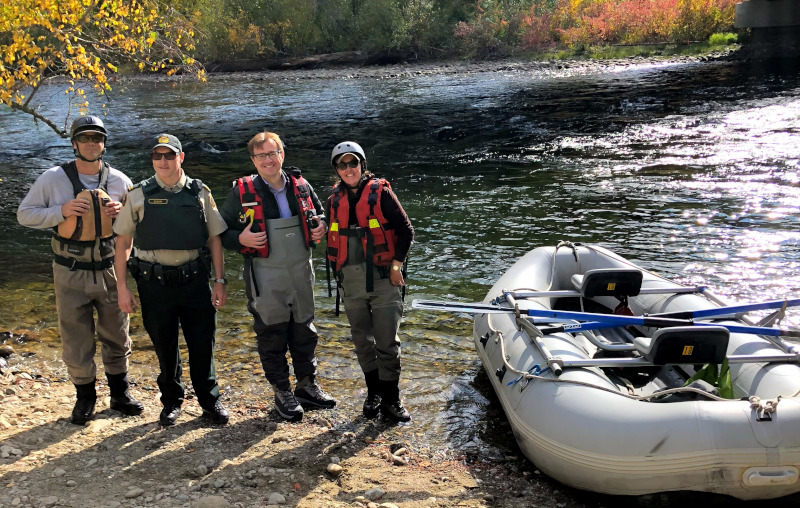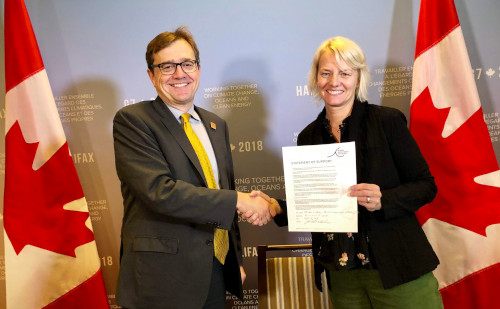The Ministry of Fisheries, Oceans, and the Canadian Coast Guard
By: The Honourable Jonathan Wilkinson, P.C., M.P., Minister of Fisheries, Oceans and the Canadian Coast Guard
Canada is a maritime nation, home to the world’s longest coastline. Protecting our vast system of nature is a source of great pride for Canadians. It is also the source of many good middle-class jobs. For this reason, we’ve partnered with the United States to protect and manage the Great Lakes, and an abundance of freshwater resources.
As the Minister of Fisheries, Oceans and the Canadian Coast Guard, I spend a great deal of time considering how our government can do more to protect our environment while growing our economy.
Trade is an essential component of this. For all nations – but particularly for a country like Canada, with its large geographic expanse and relative small population base – having secure and predictable access to international trade is crucial. Our government has recognized this reality and has, over the past three years, worked to put into place a platform on which Canadian companies can grow and succeed, and the economy and society as a whole can benefit.

An ocean of opportunity
Just this past year, our government has opened up three new avenues for international trade through trade agreement: the new NAFTA, and our trade agreements with the European Union and with the Asia-Pacific region.
With these deals, Canada has become the only G7 country to have free trade agreements with all other G7 countries, giving us access to almost two-thirds of the world’s markets and its 1.5 billion consumers. And our government is keeping up with the momentum: We are setting a target to increase Canada’s overseas exports by 50 percent by 2025. We know more has to be done to help Canadian exporters take advantage of the opportunities created by the trade agreements we have secured, and our ambitious Export Diversification Strategy will do just that. Our proposed measures will invest $1.1 billion over six years to help Canadian businesses access new markets.
The economic scale
The fish and seafood sector is a growing sector in Canada; it employs over 76,000 workers from coast to coast. In 2017, the commercial fishing industry landed almost $3.9 billion worth of fish and seafood, and is now the single largest food commodities exported by Canada, valued at almost $7 billion, annually. This sector is incredibly important to the economic vitality of Canada.
The New NAFTA
The new Canada-United States-Mexico Agreement on trade is good news for Canada’s fisheries and seafood industries. The fisheries and oceans commitments in this deal are the strongest in any free trade agreement in the world. They will help grow Canada’s ocean economy and will protect this critical ecosystem for our children and grandchildren.
Under the new NAFTA, our fish harvesters and seafood industries will continue to have tariff-free access to our largest seafood export market, the United States. Canada’s exports to the U.S. topped $4.3 billion in 2017. Ensuring that our fish, crab, lobster, and other products can be sold to the U.S. – tariff free – is critical to supporting middle-class families and creating jobs.
Beyond the direct economic importance of the new NAFTA, this agreement contains significant measures focused on promoting and enhancing ocean health – actions that will help to ensure that our children and grandchildren can enjoy all of the benefits our oceans provide.
Through this agreement, our three countries have committed to promoting trade in sustainably managed fisheries, to preventing overfishing, and to working together to protect marine habitat from pollution and invasive species.
The European Union
The trade agreement between Canada and the European Union, CETA, is an ambitious bilateral trade agreement with tremendous economic potential for the fish and seafood sector. CETA provides Canada with preferential access to more than 500 million consumers across the European Union. Before CETA, EU tariffs for fish and seafood averaged 11 percent and could reach as high as 25 percent. Today, almost 96 percent of EU tariff lines for fish and seafood products have become duty-free. This is great news for our exporters.
The Asia-Pacific
Since being elected, our government has worked with other key Asia-Pacific countries to negotiate and conclude the Comprehensive and Progressive Agreement for Trans-Pacific Partnership – otherwise known as the CPTPP – which taps into 10 nations, including markets such as Japan, Vietnam, and Singapore.
Since December 30, 2018, the CPTPP entered into force among the first seven countries, including Canada, Australia, Japan, Mexico, New Zealand, Singapore, and Vietnam with completion of respective domestic ratification processes. Once fully implemented, the CPTPP will form one of the largest trading blocs in the world, representing 13.5 percent of global GDP, and providing preferential access to a market of 500 million new consumers for Canadian products. The countries in the Asia-Pacific region are home to some of the world’s fastest-growing middle-classes. The CPTPP is the cornerstone for Canada’s greater engagement with these countries and solidly anchors Canada’s place in this growing market.
I should note that the CPTPP also incudes a chapter on small and medium sized enterprises – aimed at making it easier for first time exporters to grow their companies abroad. It establishes a framework for cooperation in areas of mutual interest such as mitigating the impact of climate change, promoting and conserving biodiversity, addressing the illegal wildlife trade, combating invasive species, and promoting sustainable fishing practices.
Once the CPTPP is fully implemented, 100 percent of fish and seafood tariff lines will be duty-free, leading to more competition and increased export potential for Canadian seafood and fish sectors in these markets. This, in turn, will result in greater job creation and higher wages for middle-class Canadians.
 Innovating for the future
Innovating for the future
Through all of these trade initiatives, the Government of Canada is helping small and medium-sized enterprises build the skills and capacity to compete globally by linking Canadian businesses to global supply chains, multi-nationals, and global infrastructure projects.
Further, as of January 1st we have lowered the small business tax rate, yet again, from 11 percent to 9 percent, giving Canada one of the lowest small business tax rates in the world, and giving small businesses up to $7,500 a year in savings.
Canada has been investing in innovation and the adoption of clean technologies so Canada’s fish and seafood industries can be more sustainable, productive, and competitive. Close to $500 million in national and targeted provincial funds focused on innovation, infrastructure, and science help our world class fish and seafood sector meet the ever growing global demand for high quality and sustainably-sourced Canadian fish and seafood products.
Much of this work follows our historic $1.5 billion Oceans Protection Plan, the largest investment ever made to protect Canada’s coasts and waterways. Under this plan, a world-leading marine safety system is being created, and marine ecosystems are being protected and restored. Stronger Indigenous partnerships, engaged coastal communities, and science based decisions are supported.
Canada actively supports science, technology, and innovation. The industry-led Ocean Supercluster is a national undertaking positioning Canada to be a global leader in the ocean economy, including sustainable aquaculture, a sector with great opportunity for coastal communities and for middle-class jobs. Research, development, and infrastructure investments are encouraged and clean technology is supported. The regulatory process is being streamlined. Ocean resources combined with a strong science-based framework for aquaculture sustainability and growth, and preferred access to markets around the world, are among Canada’s most significant advantages.
Responsible leadership makes good business
Canada is also stepping up as a leader on the world stage by making oceans a central theme of our G7 Presidency in 2018. The focus is on combating illegal, unregulated, and unreported fishing; tackling marine litter and plastics, including ghost gear from fishing vessels; and increasing the capacity of small island developing states and least developed coastal states to strengthen science and promote sustainable fishing practices around the globe.
Our government recognizes that a healthy vibrant ocean with strong fisheries management and a sustainable aquaculture industry is key to both protecting our environment and growing the economy. We are committed to continuing the momentum on both fronts – as businesses begin to take hold of the economic opportunities opened up through free trade agreements.
AT A GLANCE
WHO: The Ministry of Fisheries, Oceans, and the Canadian Coast Guard
WHAT: A ministry of the Canadian Government
WHERE: Ottawa, Canada
WEBSITE: www.dfo-mpo.gc.ca


